How Long Does Fresh Salsa and Pico de Gallo Last?
Shelf Life Explained
Fresh salsa and pico de gallo bring a vibrant and zesty flavor to a variety of dishes, making them popular accompaniments in many cuisines. Understanding the shelf life of these condiments is crucial for maintaining their freshness and ensuring food safety. Typically, homemade pico de gallo will retain its optimal taste and texture for about 3 to 7 days when stored in the refrigerator in a tightly sealed container.
The longevity of pico de gallo is influenced by factors such as ingredient freshness, preparation methods, and storage conditions. For instance, using freshly picked tomatoes (What wine goes well with tomatoes?) and promptly refrigerating the salsa after preparation can help extend its freshness. Keeping the refrigerator temperature at or below 40°F (4°C) is also vital to slow down the growth of bacteria and preserve the quality of the salsa.
Commercial varieties of fresh salsa and pico de gallo may have preservatives that can extend their shelf life slightly beyond homemade versions. However, for both homemade and store-bought options, it is recommended to adhere to any storage instructions provided and to use sensory cues—such as smell, taste, and appearance—to determine if the salsa is still enjoyable and safe to consume.
Fundamentals of Fresh Salsa and Pico de Gallo
Fresh salsa and pico de gallo are vibrant condiments that can enhance the flavor of numerous dishes. Understanding their composition and differences is crucial for appreciating their culinary roles.
Defining Fresh Salsa and Pico de Gallo
Fresh salsa, often known as "salsa fresca," refers to a sauce predominantly made with raw ingredients including tomatoes, cilantro, and lime juice. Commonly used for dipping or as a topping, it is characterized by its slightly liquid consistency. Pico de gallo, on the other hand, is a type of fresh salsa featuring a chunkier texture with less liquid, which maintains distinct pieces of its core ingredients.
Key Ingredients
Typically, the components of both fresh salsa and pico de gallo include the following:
Tomatoes: Fresh, ripe tomatoes are essential, providing the base and distinct flavor.
Cilantro: Gives a fresh, herby taste that is signature to these salsas.
Lime Juice: Adds acidity and freshness, balancing the flavors.
Salt: Enhances and melds the flavors of the other ingredients.
Onion: Usually raw, it contributes a sharp bite and depth of flavor.
The proportions and specific types of these ingredients may vary according to individual recipes.
Primary Differences
While fresh salsa and pico de gallo share ingredients, the main distinctions lie in their:
Texture: Pico de gallo is chunkier, while fresh salsa has a more puréed appearance.
Fluid Content: Salsas typically have a more liquid consistency due to the juices released from the tomatoes and additional ingredients such as vinegar or citrus juice.
These differences influence not only their use in dishes but also their shelf life once prepared.
Shelf Life and Storage
Managing the shelf life of fresh salsa and pico de gallo hinges on proper storage to maintain freshness and prevent spoilage.
Optimal Storage Conditions
The prime factor in prolonging the freshness of salsa and pico de gallo is temperature control. These items should be stored in an environment that inhibits bacterial growth. The ideal temperature range for storing these fresh condiments is between 35°F (1.7°C) and 40°F (4.4°C), which is typically the temperature of a household refrigerator.
Refrigeration and Shelf Life
When kept in the refrigerator at the proper temperature, fresh pico de gallo has a shelf life of 3-7 days. Meanwhile, fresh salsa is best consumed within 4-6 days for optimal quality. Both should be stored in:
An airtight container to minimize exposure to air and moisture.
The main body of the fridge rather than the door, to maintain consistent temperature.
Condiment Shelf Life in Fridge Pico de Gallo 3-7 days Fresh Salsa 4-6 days
Signs of Spoilage
Identifying when salsa or pico de gallo has gone bad relies on sensory evaluation. They should be discarded if:
There is any foul odor, suggesting bacterial or fungal growth.
The tomatoes become mushy and the color appears dull.
The product has visible mold growth or an abnormal change in texture.
Preparation Techniques
In creating fresh salsa and pico de gallo, preparation techniques are crucial to maximize both taste and longevity. A particular focus on ingredient quality and cutting methods underpins the best possible outcomes.
Best Practices for Freshness
Selecting Ingredients: One should opt for ripe tomatoes and other fresh ingredients, as their peak ripeness imparts the best flavor and texture.
Preserving Freshness: To maintain freshness, ingredients must be handled properly. Once chopped, they should be stored in the refrigerator if not used immediately. Utilizing acidic components like lime juice can also aid in preservation.
Chopping and Dicing Methods
Consistent Sizes: Chopped ingredients should be uniform in size to ensure even distribution of flavors and an appealing texture.
Draining Excess Liquid: After dicing, especially tomatoes, one should drain excess liquid to prevent a watery salsa. This step will enhance the salsa's or pico de gallo's shelf life and consistency.
Usage and Serving Suggestions
Fresh salsa and pico de gallo are versatile condiments that can enhance a variety of dishes. The following suggestions aim to guide users on how best to incorporate these flavorful toppings into meals while being mindful of portion sizes and caloric content.
Common Pairings
Tacos: Fresh salsa or pico de gallo adds a vibrant, refreshing taste to both meat and vegetarian tacos.
Tortilla Chips: Serve as a dip for a classic snack combination.
Salads: A spoonful of fresh salsa can serve as a low-calorie dressing option.
Burritos and Quesadillas: Incorporate into these dishes for an extra layer of flavor.
Nachos: Top a pile of nachos with generous scoops of salsa to complement the melted cheese and other toppings.
Serving Size and Calories
Tacos: A standard serving size is about 2 tablespoons, adding roughly 5-10 calories.
Tortilla Chips: Typically, 1/4 cup of salsa is used for dipping, accounting for 20-30 calories.
Salad: Using 1/2 cup as a dressing substitute totals approximately 40-60 calories.
Burritos/Quesadillas: A spread of 1/4 cup inside these dishes contributes an additional 20-30 calories.
Nachos: Depending on the number of servings, 1/2 to 1 cup of salsa may be used, summing up to 80-120 calories as a topping.
Each use case emphasizes pico de gallo or salsa as a flavorful, low-calorie addition to a variety of popular dishes.
Culinary Variations
In the realm of fresh salsa and pico de gallo, culinary variations are often influenced by regional tastes and the utilization of alternative ingredients. These variations can significantly affect both the flavor profile and shelf life of the product.
Regional Flavors
Mexican Salsa: Traditional Mexican salsas like salsa verde are typically made with tomatillos and green chilies such as serrano or jalapeño peppers. Pico de gallo, also known as salsa fresca, remains a staple with its classic combination of Roma tomatoes, onions, cilantro, fresh peppers, and lime juice. The regional preference may dictate the type of pepper used, with some regions favoring the hotter serrano over the milder jalapeño.
Salsa Verde: This green salsa gains its punch from tomatillos and is enhanced with garlic, lime juice, and sometimes avocado for a creamy texture.
Alternative Ingredients
When it comes to alternative ingredients, cooks often experiment with the basics of a pico de gallo recipe to cater to different palates or to create a unique dish.
Tomatoes: While Roma tomatoes are favored for their firmness and fewer seeds, some recipes call for different varieties, which can alter both taste and consistency.
Peppers: A switch from jalapeño to serrano pepper can significantly increase the heat levels, while bell peppers offer a sweeter, milder flavor.
Additions: Ingredients such as mango, pineapple, or even corn can be added to create a twist on the traditional recipe, potentially impacting its shelf life due to varying acidity and moisture levels of these additions.
By recognizing these culinary variations, one can appreciate the diversity and adaptability of fresh salsa and pico de gallo, which are reflective of the myriad flavors found across different regions and personal tastes.
Health and Nutrition
When considering the health and nutrition of fresh salsa and pico de gallo, one should note the caloric content and the nutritional value that these foods provide. They are often composed of fresh vegetables and, in some cases, fruit, making them a suitable option for those following a vegan diet.
Caloric Content and Nutritional Value
Fresh salsa and pico de gallo are generally low in calories, making them a healthy addition to various meals. A typical serving size of about 100 grams of pico de gallo contains roughly:
Calories: 17 kcal
Protein: 0.7g
Carbohydrates: 3.7g
Fat: 0.1g
Vitamin C: Good source
Potassium: Present
Phosphorus: Present
These condiments are often rich in vitamin C due to the presence of ingredients like tomatoes and lime juice. Potassium and phosphorus also contribute to their nutritional profile.
Dietary Considerations
Pico de gallo and fresh salsa are advantageous for a variety of diets, including vegan diets, due to their vegetable content. They are also inherently gluten-free and contain no animal products. Their low-fat nature and absence of added sugars make them a heart-healthy choice when consumed in moderation. These fresh condiments can contribute to one's overall vegetable intake, which is a cornerstone of many dietary recommendations.
Preservation Methods
Proper preservation methods ensure that the freshness and safety of salsa and pico de gallo are maintained longer. Adhering to these tactics can make a substantial difference in shelf life.
Extending Shelf Life
To extend the shelf life of fresh salsa and pico de gallo, refrigeration is crucial. An airtight container is essential to minimize exposure to air and potential contaminants. Salsas and pico de gallo should be stored at temperatures between 35°F (1.7°C) and 40°F (4.4°C), which inhibits bacterial growth and slows the oxidation process.
Store in an airtight container to prevent contamination and oxidation.
Keep refrigerated between 35°F (1.7°C) and 40°F (4.4°C).
Freezing Instructions
Freezing fresh salsa or pico de gallo is a viable option for long-term preservation. When preparing to freeze, use freezer-safe containers or bags and leave some space at the top as the contents will expand. Seal tightly to prevent freezer burn, which can significantly degrade the quality.
Transfer to freezer-safe containers or bags, leaving space for expansion.
Seal tightly and label with the date and contents.
Store in the freezer for up to 3 months.
Common Questions
In assessing the longevity of fresh salsa and pico de gallo, one must consider storage conditions and ingredients involved. These factors play a crucial role in the preservation and safety of these condiments.
FAQs
How long does fresh salsa typically last in the refrigerator? Fresh salsa usually remains good for consumption for 4-7 days when stored in the fridge in a sealed container at a temperature of 35°F (1.7°C) to 40°F (4.4°C).
What is the optimal temperature for storing pico de gallo? To prolong its freshness, pico de gallo should be kept in the refrigerator between 35°F (1.7°C) and 40°F (4.4°C).
Can you freeze pico de gallo? Freezing pico de gallo is not generally recommended, as the texture will substantially change upon thawing, affecting the quality of the fresh ingredients.
How can one tell if pico de gallo has gone bad? Indicators of spoilage include an off smell, discoloration, or a slimy texture. If any of these signs are present, the pico de gallo should be discarded.
Does pico de gallo last as long as commercially prepared salsas? Pico de gallo does not typically last as long as commercially prepared salsas due to the lack of preservatives. It's best to consume it within 3 to 4 days for optimal quality.
Additional Tips and Tricks
To enhance the longevity and flavor of fresh salsa and pico de gallo, one must consider how the ingredients are prepared and combined. Fine-tuning recipes and making adjustments cater to personal taste and can impact the salsa's shelf life.
Enhancing Flavor
Using ripe tomatoes is crucial for a robust flavor as they are juicier and sweeter. One can enhance the taste of salsa by letting it sit for a few minutes after preparation; this allows the flavors to mingle. Fresh lime juice can be adjusted to taste but also acts as a preservative due to its acidity, which may help extend the freshness when stored properly.
Recipe Adjustments
For a milder salsa, the seeds and membranes of the peppers should be removed before dicing. One can experiment with seasonings, like adding cumin or garlic powder, to introduce new flavors. It's also possible to tailor the salsa with variations such as incorporating fruits like mango or pineapple for a sweet twist.







